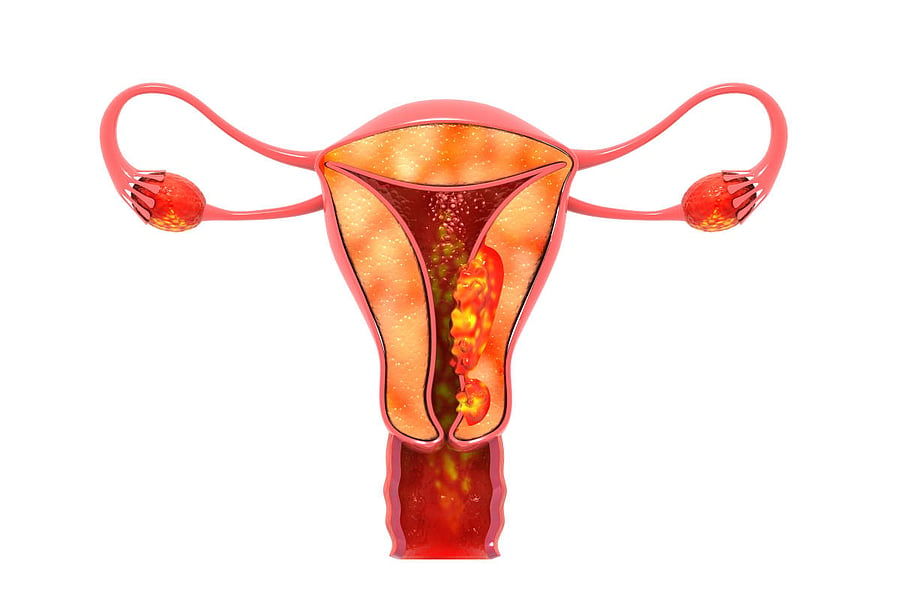
Endometrial or uterine polyps are a very common gynaecological disorder in women especially during their reproductive age and one of the most common causes of abnormal uterine bleeding, such as bleeding between periods. These polyps can be single or multiple and are found during both reproductive and postmenopausal phases of life. In other words, an overgrowth of the inside lining of the uterus which is called the endometrium leads to polyps. They range in size from about 5 mm to as large as filling the whole uterine cavity. The polyp could be made up of normal cycling endometrium or simple to complex hyperplastic endometrium. It is rare that endometrial cancer is found in women in older age groups.
Symptoms of uterine polyps
Many times, symptoms of polyps, might be asymptomatic but abnormal uterine bleeding is the most common presenting symptom occurring in approximately 68% of women. However, in younger women, abnormal bleeding is seen less often. Increasing age is the most common risk factor for their occurrence. Signs to watch out for are:
Irregular menstrual bleeding — for example, having frequent, unpredictable periods of variable length and heaviness.
Bleeding between menstrual periods.
Excessively heavy menstrual periods.
Vaginal bleeding after menopause.
Having a problem with conception and facing fertility-related issues.
Women with underlying fertility problems are more likely to be diagnosed with an endometrial polyp. While small polyps often resolve spontaneously, these are present in about 25% of patients. However, malignancy arising in polyps is rare and its risk increases with increasing age. Postmenopausal women on hormone replacement therapy (HRT) and obese women have been found to have a higher incidence of endometrial polyps.
Causes of uterine polyps
Experts don’t know exactly why women get uterine polyps but in all probability, they are linked to changes in hormone levels. Each month, your estrogen levels rise and fall, causing the lining of your uterus to thicken and then shed during your period. Polyps form when too much of that lining grows.
One is age as they’re more common in your 40s or 50s. That may be due to the changes in estrogen levels that happen just before and during menopause. These can also occur if you have obesity or high blood pressure.
Diagnosis
Transvaginal ultrasound scan (TVUS) is the investigation of choice for EP. It is best done on or around the 10th day of the menstrual cycle when the endometrium is thinnest grown. The use of colour doppler increases the sensitivity of the scan to diagnose EP. TVUS with saline instillation into the uterus increases diagnostic accuracy for EP. It outlines small endometrial polyps which could be missed in TVUS. In some advanced stages, Hysteroscopy or Hysterosonography may also be recommended to patients. A hysteroscopic removal of EP remains the gold standard for treatment.
Hysteroscopic polypectomy is a daycare procedure that is done under anaesthesia. The polyp after removal is sent for histopathologic examination to rule out malignancy.
Nexus between EP & infertility
While the reason is unclear, it has been found that there is a connection between polyps and infertility. The location of the polyps could be preventing the embryo from implanting in the uterus. These growths can block the cervical canal and even prevent sperm from fertilising the egg. In primary infertility, the incidence of EP varies from 3.8%–38.5%, and it is 1.8%–17% in secondary infertility. Various mechanisms are involved in it. It could also prevent implantation of the embryo into the endometrium acting as a space-occupying lesion. It is also felt that polyps may create inflammation in the lining of the uterus similar to an intrauterine device (Cu-T) disturbing implantation of the embryo. Restoration of reproductive ability is not dependent on the size of the polyp excised.
Studies involving in vitro fertilisation (IVF) patients have shown that hysteroscopic polypectomy prior to IVF resulted in a better chance of pregnancy. In some of them, after polypectomy, spontaneous pregnancy was obtained while waiting for treatment. Asymptomatic endometrial polyp is a commonly encountered problem, which may afflict 25% of women with unexplained infertility, and may only be detectable on hysteroscopy. If these endometrial polyps are not diagnosed and adequately treated, infertility treatments may not yield results.
Resection of the endometrial polyp via hysteroscopy has been shown to be a beneficial procedure when performed prior to starting assisted reproductive treatments, such as intrauterine inseminations and in-vitro fertilisations (IVF).
(The author is a senior fertility specialist.)